E-Archive
Cover Page
in Vol. 14 - May Issue - Year 2013
How Can Different Blasting Abrasives Be Assessed Objectively? – Ervin Test –
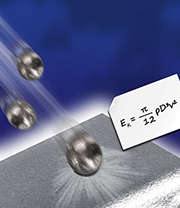
Performance measurement of steel shot

C = carbon content in % Table 1: Framework conditions for comparing Ervin Tests
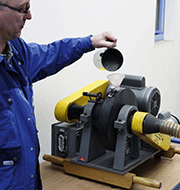
Picture 1: Ervin Tester with spinner
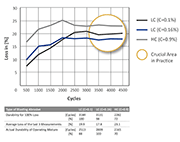
Diagram 1: Results for determination of durability
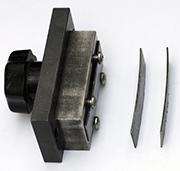
Picture 2: Almen strip brackets and three Almen strips after having measured the blasting intensity
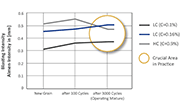
Diagram 2: Almen blasting intensity before and during cold twisting (100 cycles) and after completed cold twisting (3000 cycles)
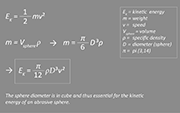
Formulas concerning kinetic energy
How can one find the objectively best blasting abrasive? The requirements of customers on surface treatment are increasingly growing. The blasted products should not only be clean but must also meet the standards of surface roughness (quality). The gloss level of the blasted surfaces is a further success factor.
How can one, as an operator of a blasting system, determine the most efficient and qualitatively most high-end blasting abrasive?
Not only for foundries are blasting abrasives of steel the first choice. A lot of manufacturers bustle in the market. As an assessment criterion prior to a field test, the Ervin Test is approved and useful.
Virtually each manufacturer of abrasives has this testing method available and argues over it. In practice, a comparison of results from Ervin Tests is, despite the standardized procedure, often very difficult.
Here are some important rules that should be observed when comparing assessments by Ervin Tests.
By using the Ervin Test, two basic economical parameters can be compared. Life (durability) and blasting intensity (cleaning performance) of blasting abrasives are determined.
Life makes a point on the durability of the blasting abrasives and the blasting intensity gives information on the effectiveness on the surface to be blasted (transmitted kinetic energy).
To be able to do a scientific assessment on efficiency, both parameters must always be determined and other framework conditions must be kept as constant as possible.
This is the advantage of a test under lab standards, as variations and changes in installation engineering, which are common in practice, can be blinded out as far as possible. But there is one constraint: to know from practical experience that durability measurements are only comparable when they have been conducted on the same Ervin tester.
To show the pitfalls of results from Ervin Tests, three blasting abrasives from the same grain size fraction of approximately 1.5 – 2.2 mm from different well-known manufacturers are compared. The blasting abrasive market divides into High Carbon (HC) and Low Carbon (LC) materials. For measurements, one HC and two LC products have been used.
In the following Table 1, you can see the framework conditions of blasting abrasive samples:
To be able to compare grain size fractions, the Ervin Test report should include an accurate sieving or an average grain class.
The separator sieve indicates the grain size when the grains are dropped out of the blasting system. In practice, this is done by an air separator; in the laboratory, the small grain is dropped out after 500 blasting abrasive cycles at any one time. With comparative measurements this separator sieve has to be absolutely identical, otherwise there will be an obvious falsification of the determination of durability.
The hardness of the blasting abrasives should be stated both in the new grain and the operating mixture, therefore at the end of an Ervin Test. This value is a first indicator for the durability and the blasting intensity of blasting abrasives. As a rule, with increasing hardness, durability goes down and cleaning performance goes up.
As Table 1 emphasizes, an LC blasting abrasive has – while being used – a clearly stronger cold hardening than a comparable HC abrasive.
Determination Of Durability
The Ervin Tester in Picture 1 consists of one chamber with an integrated spinner and winnowing fans that pointedly drop the tested material (as a rule 100 g) at a standardized speed on a surface. At the bottom, there is a collecting basin from which the blasting abrasive is taken again on the spinner after a completed cycle. In doing so, a register mechanism records exactly how many cycle periods are done with the quantity to be tested. After 500 cycle periods, there is a sampling. The share below the separator sieve is filtered and the amount of losses is determined.
After having determined the missing share out of 100 grams (100%) starting quantity is filled up with new grain and the next 500 cycles in the blasting system are started. If the sum of losses is higher than the starting quantity of 100 grams, the number of cycles achieved up to that time is called "durability for 100% loss".
In practice, this is the common statement for the durability of the blasting abrasives in Ervin test reports.
In Diagram 1 the losses of 3 samplings after cycle periods of 500 cycles each and the resulting "durability for 100% loss" are stated.
The crucial source of error of the measuring result "Durability for 100% Loss" lies in the fact that a formed operating mixture does not yet exist at the beginning of the determination of durability. In practice, the blasting abrasive does exist as an operating mixture, a mixture of new and old, partly crushed grains. With the common determination of durability by using an Ervin Test, the running-in period up to the formation of an operating mixture is completely integrated into the measurement whereby the real application rate is falsified.
In practice, there are amazing differences of the blasting abrasive loss in the running-in condition compared to the finished operating mixture.
Standard DIN 50315 describes a suitable process for determining the practically relevant rate of the durability among the three samples. In doing so, the 500 cycle periods are measured till such time as the last three loss values do not vary more than 0.5%. Thus a steady loss in operating mixture state can be determined. These three values are averaged and then converted as the real durability in the cycles. This procedure offers a realistic comparability of the operating mixtures.
Diagram 1 shows that there is a clear shift of over 10% with the samples in favour of LC (C=0,16) and HC (C=0,9) samples. Yet the durability of the high-carbon HC sample is still lower. Thus you can come to the conclusion that a lower hardness does not guarantee a long durability in the operating mixture.
But, known from operational experience, high-carbon (HC) blasting abrasives are not able to reach the durability of low-carbon (LC) abrasives.
When doing Ervin measurements to compare durability, pay special attention to the last three loss values because in this area, an operating mixture should be formed.
It is to be emphasized that this measuring method is a standardized process for determining the abrasive quality. However, in operational practice there can be deviations to the laboratory results due to variations of installation engineering or, for example, a carryover of blasting abrasive from the tester by dipped work pieces.
A good documentation of abrasive consumption, for example, of the tonnage of blasted cast or the gross melting performance and notes on the accruing products which have to be re-blasted are the fundament for reaching and proving an efficient operation of the blasting system. Especially, the re-blasting rate is often a crucial parameter for efficiency. This leads to the second essential parameter which can be determined by Ervin Tests.
Determination Of Blasting Intensity (Transmitted Kinetic Energy)
The process for determining the blasting intensity, thus the efficiency on the surface of the parts to be blasted, measures the kinetic energy transferred to the product to be blasted by the deflection of a standardized metal strip (Almen strip). At the beginning, there is no deflection of the metal strip. It is screwed on mounting brackets (Picture 2) placed in the Ervin tester, and whose surface is blasted with a known number of blasting cycles.
In this case, 20 blasting cycles at a time were done for the determination. After the test, the Almen strip is removed and the maximal deflection (in mm) is measured. The results are shown in Diagram 2.
Despite identical "Average grain size" in new grain condition, there is a clear difference in the penetrating power of the three tested materials. At the beginning, there is an obvious dependence of the hardness of the blasting abrasives in new grain condition on their blasting intensity. The blasting intensity of the soft LC (C=0.1) clearly lags behind the competitors. After 100 blasting cycles, the high-carbon abrasive (C=0.9) has – as expected –by far the highest blasting intensity. According to DIN 50315 the regular determination of the intensity would be completed now. However, the determination of the intensity in the formed operating mixture is – just as with the durability – the most convincing one, as it mirrors the operational practice in the most realistic way. In doing so, the result as shown in Diagram 2 is a most surprising one. The blasting intensity (deflection of Almen strip) of LC (C=0.16) has increased to 0.5 mm due to further cold hardening, whereas the intensity of HC (C=0.9) has considerably decreased, despite its still highest hardness (499 HV1 in operating mixture). Why is that?
The determination of the medium grain size in the operating mixture gives some indication of this. The hard HC material crushes substantively faster than the ductile LC blasting abrasives by which the fine share increases and this results in lower "average grain size" in the operating mixture. As the weight and with it, the diameter of the grains, reacts very strongly to the kinetic energy (see box below), the influence of the hardness is overlaid by the lower average graining in the operating mixture.
With comparing the blasting intensity, estimates in relation to the development of re-blasted products or a possible shortening of the blasting time by changing the blasting abrasive can be done. Yet with re-blasted parts, it is necessary to distinguish if the blasting performance on the surface is not sufficient or if the shape of the work piece (indentations or edges) prevents the proper use of the abrasive. In the second case, only limited positive successes can be reached by changing the blasting abrasive.
With this equipment, a reliable assessment of Ervin test comparisons is possible, and supports a sound basis of decision-making.
For Information:
Eisenwerk Würth GmbH
Jagstfelder Straße 14, Postfach 1155
74177 Bad Friedrichshall, Germany
Tel. +49.7136.9898-33
E-mail: winkler@eisenwerk-wuerth.de
www.eisenwerk-wuerth.de



























